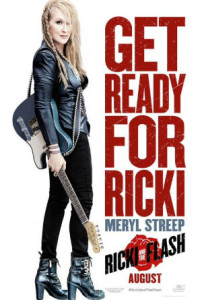Ricki and the Flash Rocks with PreSonus, Part 4
When we started rehearsals for Ricki and the Flash, we discovered that some things had to be changed. Part of what we faced was the reality of working with musicians who were used to the big stage in a club environment.
A brief review of our cast:
Drums and backing vocals: Joe Vitale. Joe has drummed for, among others, Joe Walsh (he co-wrote “Rocky Mountain Way” with Joe); Stills-Young Band; The Eagles; Crosby, Stills and Nash; and the re-formed Buffalo Springfield. Joe has written a book about his life as a musician called Backstage Pass.
Bass: Rick Rosas, aka Rick The Bass Player. Rick played most recently with Neil Young in Crazy Horse. He was also part of the Buffalo Springfield reunion. Rick passed away a few weeks after finishing the band scenes, and we miss him very much.
Keys: Bernie Worrell. Bernie was a member of Parliament/Funkadelic and joined Talking Heads for a number of albums. He’s in Jonathan Demme’s concert classic film Stop Making Sense and has played on countless sessions with artists as diverse as Keith Richards, Jack Bruce, Dee Lite, and Bootsy’s Rubber Band.
Lead guitar and backing vocals: Rick Springfield. Rick has been on the big stage since the late 1960s, first with Zoot, and then as a solo artist. For a time, Rick starred in the soap opera General Hospital, and he has many hit records, including “Speak to the Sky,” “Jessie’s Girl,” and “I’ve Done Everything for You.”
Rhythm guitar and lead vocals: Meryl Streep. One of the most well regarded actresses in the world, Meryl learned to play guitar for this movie. Meryl had never played in a band before but she has sung in many films, including Mama Mia and the recent Into the Woods, so she adapted quickly to the role of Ricki.
I have been “pushing faders” as a front-of-house (and sometimes monitor) engineer since 1979. I’ve mixed in wretched bars with “thrift-store” PA systems, and I’ve mixed bands at the New Orleans Jazz and Heritage Festival. My background is live sound; working on a movie required some adjustment in my approach to mixing.
Music coordinator Mark Wolfson and Neil Citron, the music wrangler, have worked together for many years. Among other projects, they worked on the film That Thing You Do (also with Ricki director Jonathan Demme and producer Gary Goetzman). On this film, I worked with Mark and Neil to create an authentic club band feel.
One thing that we encountered from the get-go was a reluctance to show microphones on camera. This created some interesting challenges, as we had to find a way to capture the sound without showing any microphones beyond the vocal mics. Some solutions were simple: We could take a DI off of the bass, and we used triggers on the drums and then used drum samples that we sampled from Joe’s Drum Workshop kit. We hid the hi-hat and overhead mics as best we could.
Thanks to Audio-Technica, we had excellent condensers: an ATM 450 on the hi-hat and an ATM 4050 on the overheads. We were able to hide the ATM 650 dynamic on the Leslie high side and the ATM 250 dynamic on the Leslie low side.
The guitar amps presented a problem, though. We needed to capture an authentic sound without showing mics. Trying to mic the back of the amps proved unwieldy at best. It also didn’t sound so great.
Neil and I put our heads together and decided to call our friend Peter Janis at Radial Engineering. Peter sent us two JDX active speaker-simulator direct boxes. We were able to plug out of Meryl’s Fender 65 Deluxe reissue and Rick’s Fender Bassman 410. The Bassman reissue proved tricky because the speaker output has an RCA connector; we had to make two ¼”-to-RCA custom connectors. At the time, the JDX required an external supply, as well; now it’s available with the option to run on 48V phantom power.
We also used two of the new Audio-Technica AT 4080 active ribbon mics for room/ambience miking. These mics sound glorious, and they really helped Neil and Mark re-create the room sound when they did the mixing later.
With the system tuned, we were ready to watch five musician/actors become a band.
